air conditioning CHEVROLET BLAZER 1998 2.G Owners Manual
[x] Cancel search | Manufacturer: CHEVROLET, Model Year: 1998, Model line: BLAZER, Model: CHEVROLET BLAZER 1998 2.GPages: 416, PDF Size: 22.4 MB
Page 153 of 416
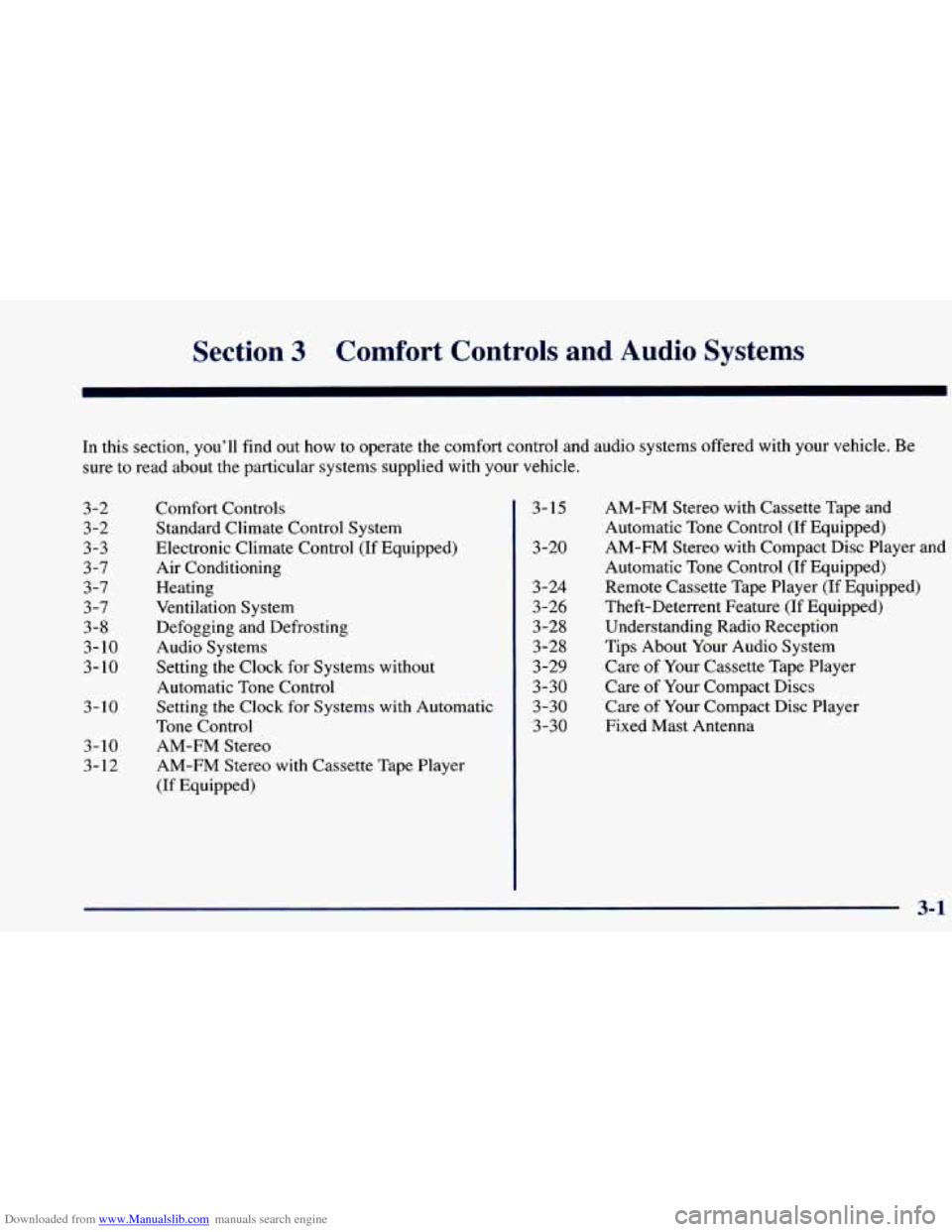
Downloaded from www.Manualslib.com manuals search engine Section 3 Cornfo-t Controls and Audio Systems
In this section, you’ll find out how to operate the comfort control and audio systems offered with your vehicle. Be
sure to read about the particular systems supplied with your vehicle.
3-2 3-2
3-3
3-7
3-7 3-7
3-8
3- 10
3- 10
3-10
3- 10
3-12 Comfort Controls
Standard Climate Control System
Electronic Climate Control (If Equipped)
Air Conditioning
Heating
Ventilation System
Defogging and Defrosting
Audio Systems
Setting the Clock for Systems without
Automatic Tone Control
Setting the Clock
for Systems with Automatic
Tone Control
AM-FM Stereo
AM-FM Stereo with Cassette Tape Player
(If Equipped) 3-15
3-20
3-24
3-26
3-28 3-28
3
-29
3-30
3-30
3-30 AM-FM
Stereo with Cassette Tape and
Automatic Tone Control (If Equipped)
AM-FM Stereo with Compact Disc Player and
Automatic Tone Control (If Equipped)
Remote Cassette Tape Player (If Equipped)
Theft-Deterrent Feature (If Equipped)
Understanding Radio Reception
Tips About Your Audio System
Care of Your Cassette Tape Player
Care of Your Compact Discs
Care of Your Compact Disc Player
Fixed Mast Antenna
Page 155 of 416
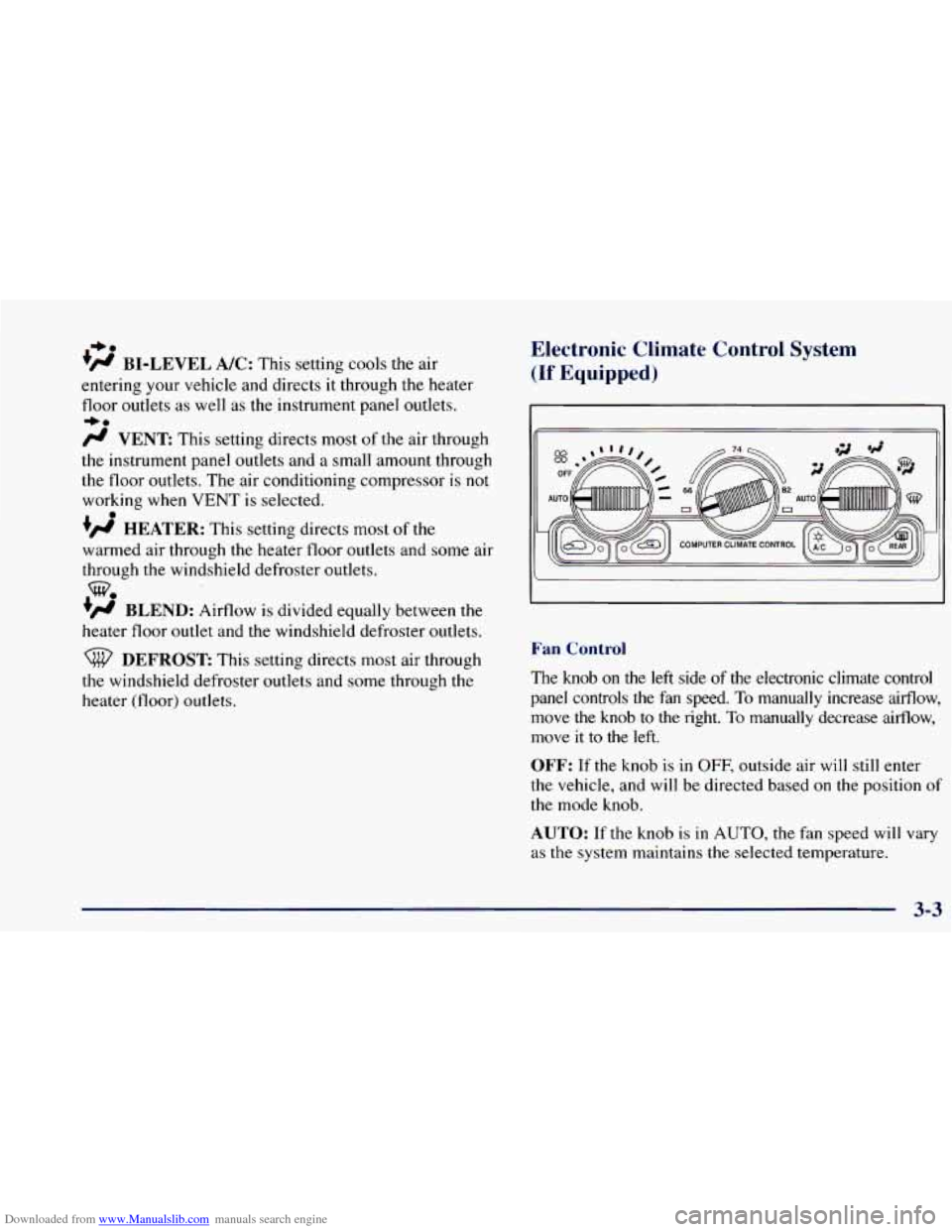
Downloaded from www.Manualslib.com manuals search engine +e
+fl BI-LEVEL A/C: This setting cools the air
entering your vehicle and directs it through the heater
floor outlets as well as the instrument panel outlets.
fl VENT This setting directs most of the air through
the instrument panel outlets and a small amount through
the floor outlets. The air conditioning compressor is not
working when VENT
is selected.
+’ HEATER: This setting directs most of the
warmed air through the heater floor outlets and some air
through the windshield defroster outlets.
+’ BLEND: Airflow is divided equally between the
heater floor outlet and the windshield defroster outlets.
DEFROST: This setting directs most air through
+0
0
w.
the windshield defroster outlets and some through the
heater (floor) outlets.
Electronic Climate Control System
(-- Equipped)
Fan Control
The knob on the left side of the electronic climate control
panel controls the fan speed. To manually increase airflow, move the knob to the right.
To manually decrease aifflow,
move it
to the left.
OFF: If the knob is in OFF, outside air will still enter
the vehicle, and will be directed based
on the position of
the mode knob.
AUTO: If the knob is in AUTO, the fan speed will vary
as the system maintains the selected temperature.
3-3
Page 156 of 416
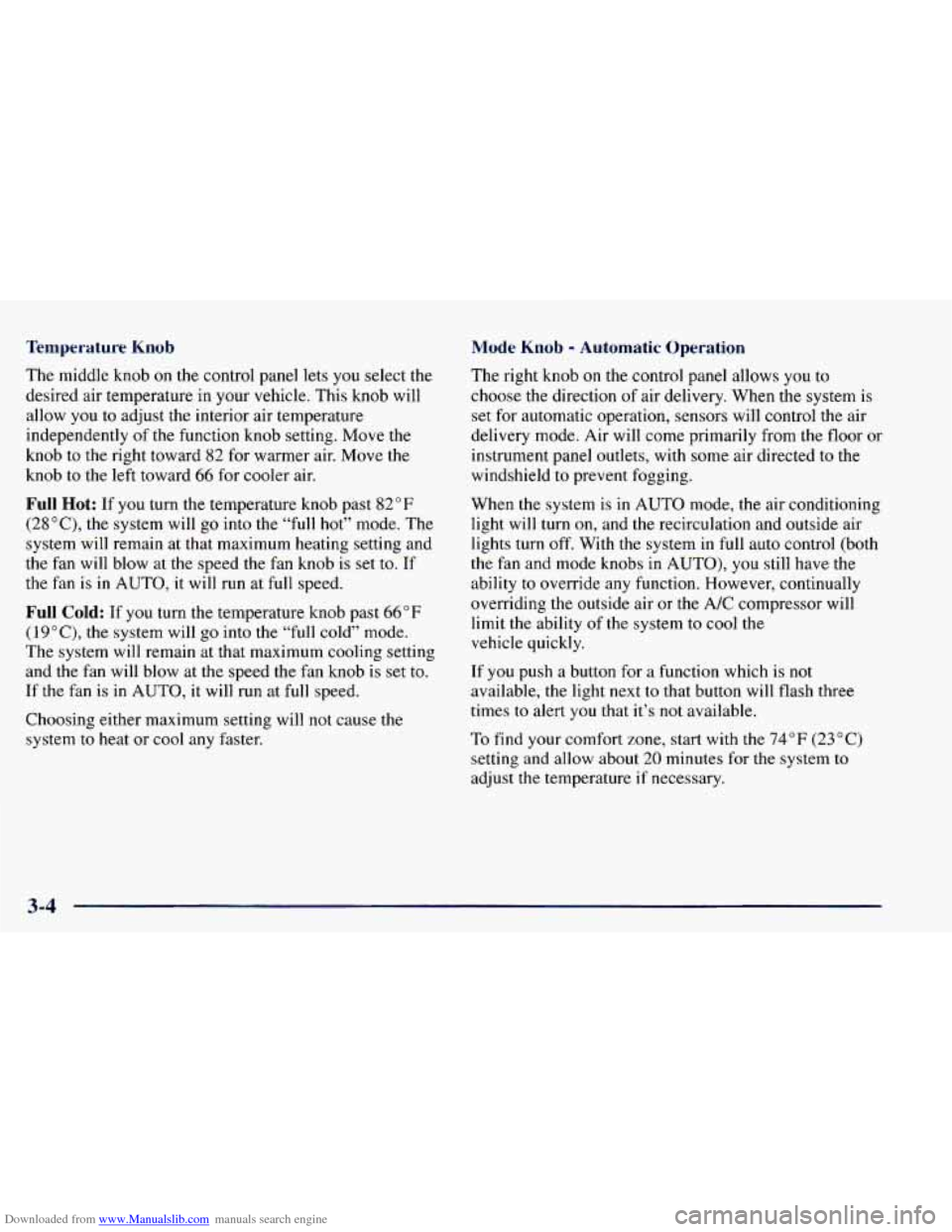
Downloaded from www.Manualslib.com manuals search engine Temperature Knob Mode Knob - Automatic Operation
The middle knob on the control panel lets you select the
desired air temperature in your vehicle. This knob will
allow
you to adjust the interior air temperature
independently
of the function knob setting. Move the
knob to the right toward
82 for warmer air. Move the
knob to the left toward 66 for cooler air.
Full Hot: If you turn the temperature knob past 82°F
(28”C), the system will go into the
“full hot” mode. The
system will remain at that maximum heating setting and
the fan will blow at the speed the fan knob is set to. If
the fan is in AUTO, it will run at
full speed.
Full Cold: If you turn the temperature knob past 66°F
(1 9”C), the system will go into the “full cold” mode.
The system will remain at that maximum cooling setting
and the fan will blow at the speed the fan knob is set to. \
If the fan is in AUTO, it will run at
full speed.
Choosing either maximum setting will
not cause the
system to heat or cool any faster. The right knob
on the control panel allows you to
choose the direction of air delivery. When the system is
set for automatic operation, sensors will control the air
delivery mode. Air will come primarily from the floor or
instrument panel outlets, with some air directed to the
windshield
to prevent fogging.
When the system is
in AUTO mode, the air conditioning
light
will turn on, and the recirculation and outside air
lights turn off. With the system in full auto control (both
the fan and mode knobs in AUTO), you still have the ability to override any function. However, continually
overriding the outside air or the A/C compressor will
limit the ability of the system
to cool the
vehicle quickly.
If
you push a button for a function which is not
available,
the light next to that button will flash three
times
to alert you that it’s not available.
To find your comfort zone, start with the
74°F (23°C)
setting and allow about 20 minutes for the system to
adjust the temperature
if necessary.
3-4
Page 157 of 416
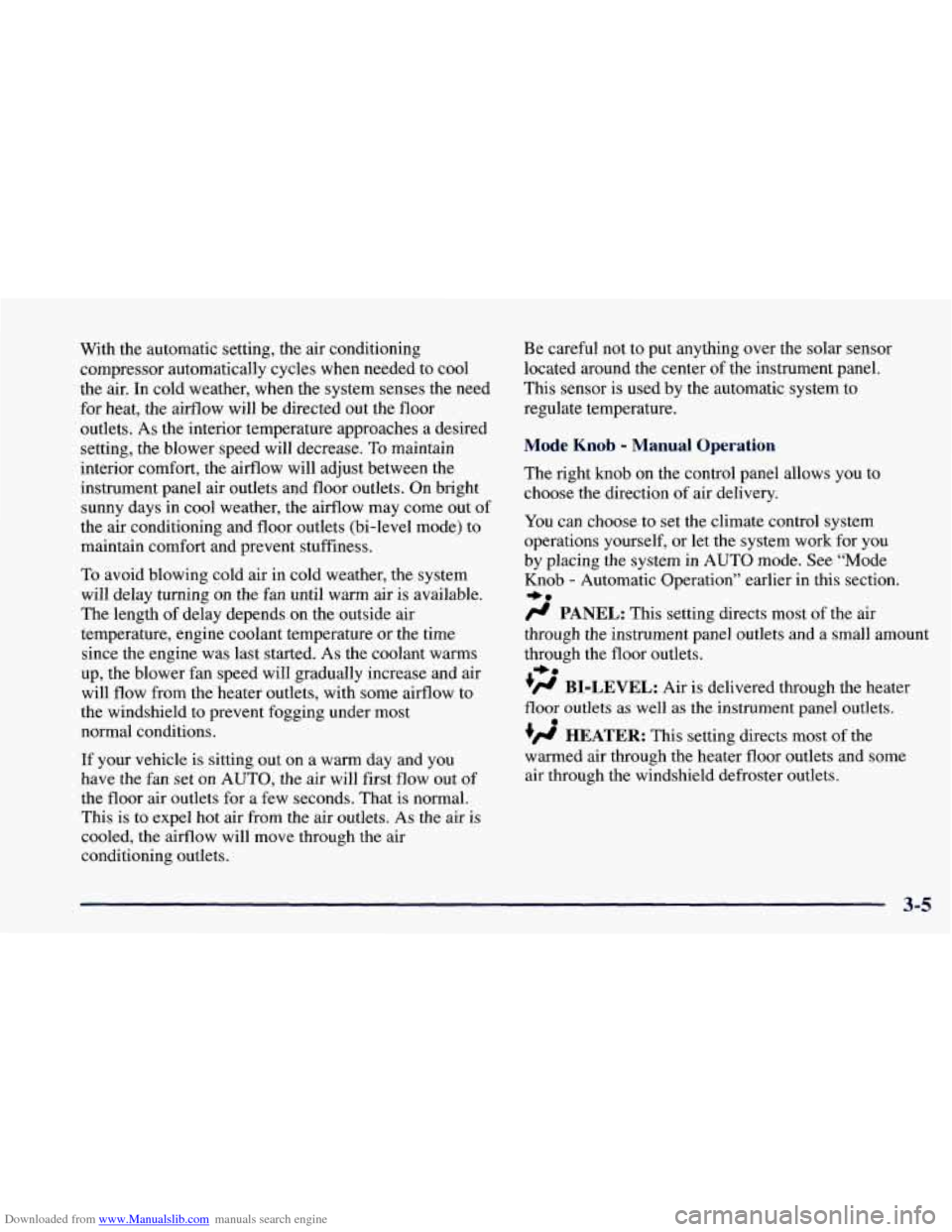
Downloaded from www.Manualslib.com manuals search engine With the automatic setting, the air conditioning
compressor automatically cycles when needed to cool
the air. In cold weather, when the system senses the need
for heat, the airflow will be directed out the floor
outlets.
As the interior temperature approaches a desired
setting, the blower speed will decrease. To maintain
interior comfort, the airflow will adjust between the
instrument panel air outlets and floor outlets. On bright
sunny days in cool weather, the airflow may come out of
the air conditioning and floor outlets (bi-level mode) to
maintain comfort and prevent stuffiness.
To avoid blowing cold air in cold weather, the system
will delay turning on the fan until warm air is available.
The length of delay depends on the outside air
temperature, engine coolant temperature or the time
since the engine was last started. As the coolant warms
up, the blower fan speed will gradually increase and air
will flow from the heater outlets, with some airflow to
the windshield to prevent fogging under most
normal conditions.
If your vehicle
is sitting out on a warm day and you
have the fan set
on AUTO, the air will first flow out of
the floor air outlets for a few seconds. That is normal.
This
is to expel hot air from the air outlets. As the air is
cooled, the airflow will move through the air
conditioning outlets. Be careful
not to put anything over the solar sensor
located around the center of the instrument panel.
This sensor is used by the automatic system to
regulate temperature.
Mode Knob - Manual Operation
The right knob on the control panel allows you to
choose the direction of air delivery.
You can choose to set the climate control system
operations yourself, or let the system work for
you
by placing the system in AUTO mode. See “Mode
Knob
- Automatic Operation” earlier in this section.
+.
fl PANEL: This setting directs most of the air
through the instrument panel outlets and a small amount
through the floor outlets.
+H BI-LEVEL: Air is delivered through the heater
floor outlets as well as the instrument panel outlets.
+’ HEATER: This setting directs most of the
warmed air through the heater floor outlets and some
air through the windshield defroster outlets.
+.
e
3-5
Page 158 of 416
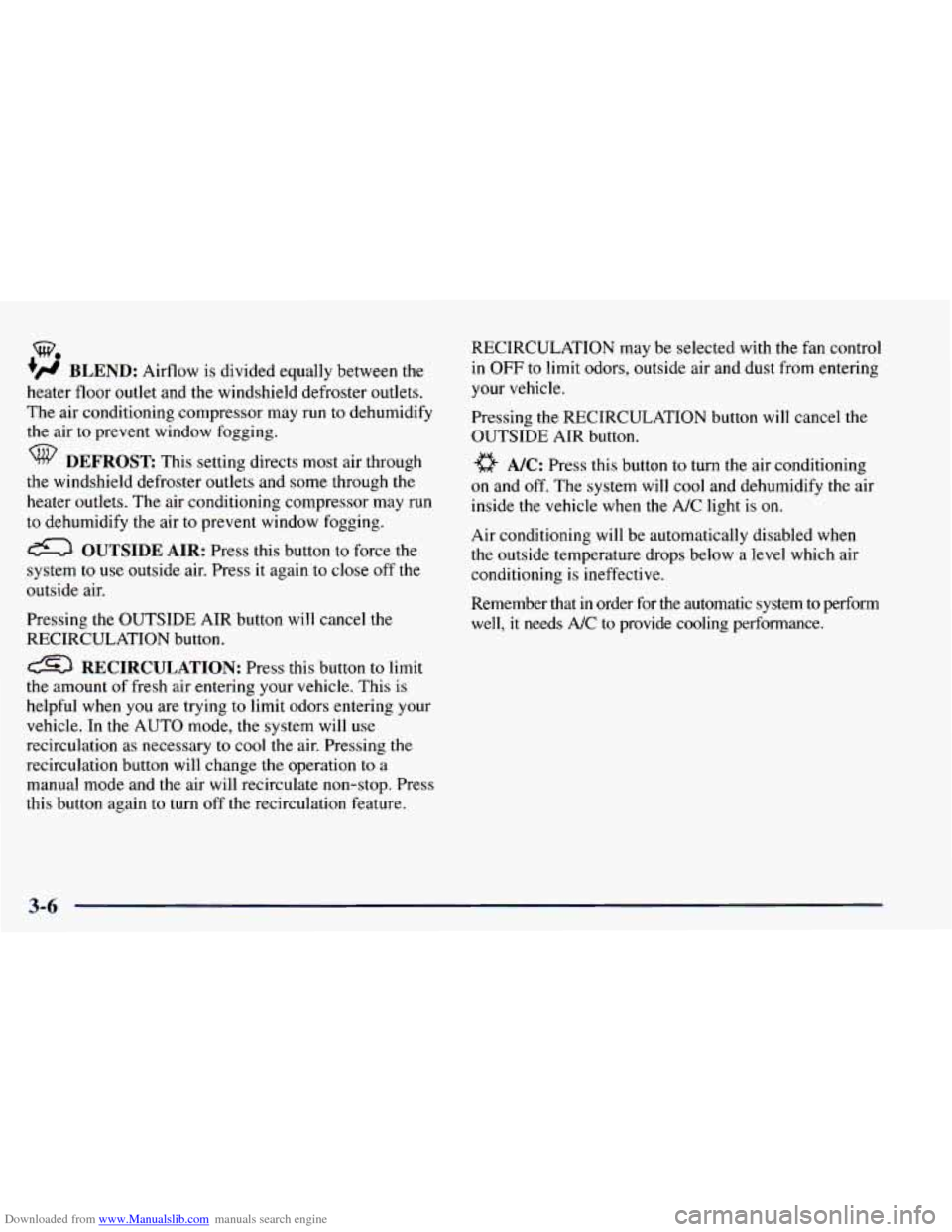
Downloaded from www.Manualslib.com manuals search engine w.
+H BLEND: Airflow is divided equally between the
heater floor outlet and the windshield defroster outlets.
The air conditioning compressor may run to dehumidify
the air to prevent window fogging.
DEFROST This setting directs most air through
the windshield defroster outlets and some through
the
heater outlets. The air conditioning compressor may run
to dehumidify the air to prevent window fogging.
a OUTSIDE AIR: Press this button to force the
system to use outside air. Press it again to close off the
outside air.
Pressing the OUTSIDE AIR button
will cancel the
RECIRCULATION button.
RECIRCULATION: Press this button to limit
the amount of fresh air entering your vehicle. This is
helpful when you are trying to limit odors entering your
vehicle. In the AUTO mode, the system
will use
recirculation as necessary
to cool the air. Pressing the
recirculation button
will change the operation to a
manual mode and the air will recirculate non-stop. Press
this button again to turn off the recirculation feature. RECIRCULATION may be selected
with the fan control
in OFF to limit odors, outside
air and dust from entering
your vehicle.
Pressing the RECIRCULATION button
will cancel the
OUTSIDE AIR button.
A/C: Press this button to turn the air conditioning
on and
off. The system will cool and dehumidify the air
inside the vehicle when the A/C light
is on.
Air conditioning
will be automatically disabled when
the outside temperature drops below a level which air
conditioning is ineffective.
Remember that
in order for the automatic system to perform
well,
it needs A/C to provide cooling performance.
3-6
Page 159 of 416
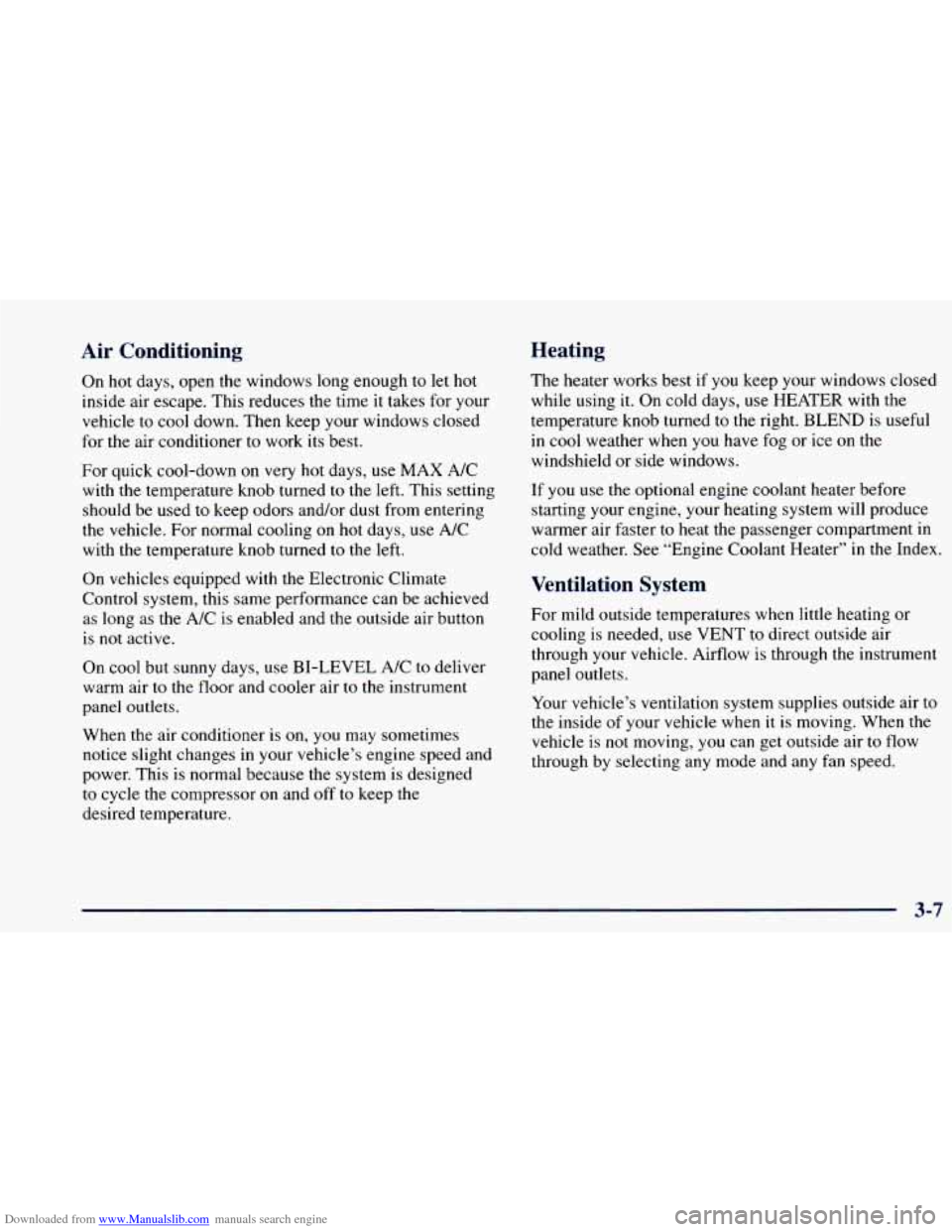
Downloaded from www.Manualslib.com manuals search engine Air Conditioning
On hot days, open the windows long enough to let hot
inside air escape. This reduces the time it takes for your
vehicle
to cool down. Then keep your windows closed
for the air conditioner to work its best.
For quick cool-down on very hot days, use MAX A/C
with the temperature knob turned to the left. This setting
should be used to keep odors and/or dust from entering
the vehicle. For normal cooling
on hot days, use A/C
with the temperature knob turned to the left.
On vehicles equipped with the Electronic Climate
Control system, this same performance can be achieved
as long as the A/C is enabled and the outside air button
is not active.
Heating
On cool but sunny days, use BI-LEVEL A/C to deliver
warm air to the
floor and cooler air to the instrument
panel outlets.
When the air conditioner is on, you may sometimes
notice slight changes in your vehicle’s engine speed and
power. This is normal because the system is designed
to cycle the compressor on and off to keep the
desired temperature.
The heater works best if you keep your windows closed
while using it. On cold days,
use HEATER with the
temperature knob turned
to the right. BLEND is useful
in cool weather when
you have fog or ice on the
windshield or side windows.
If you use the optional engine coolant heater before starting your engine, your heating system will produce
warmer air faster to heat the passenger compartment in
cold weather. See “Engine Coolant Heater” in the Index.
Ventilation System
For mild outside temperatures when little heating or
cooling is needed, use
VENT to direct outside air
through your vehicle. Airflow is through the instrument
panel outlets.
Your vehicle’s ventilation system supplies outside air to
the inside
of your vehicle when it is moving. When the
vehicle is
not moving, you can get outside air to flow
through by selecting any mode and any fan speed.
3-7
Page 271 of 416
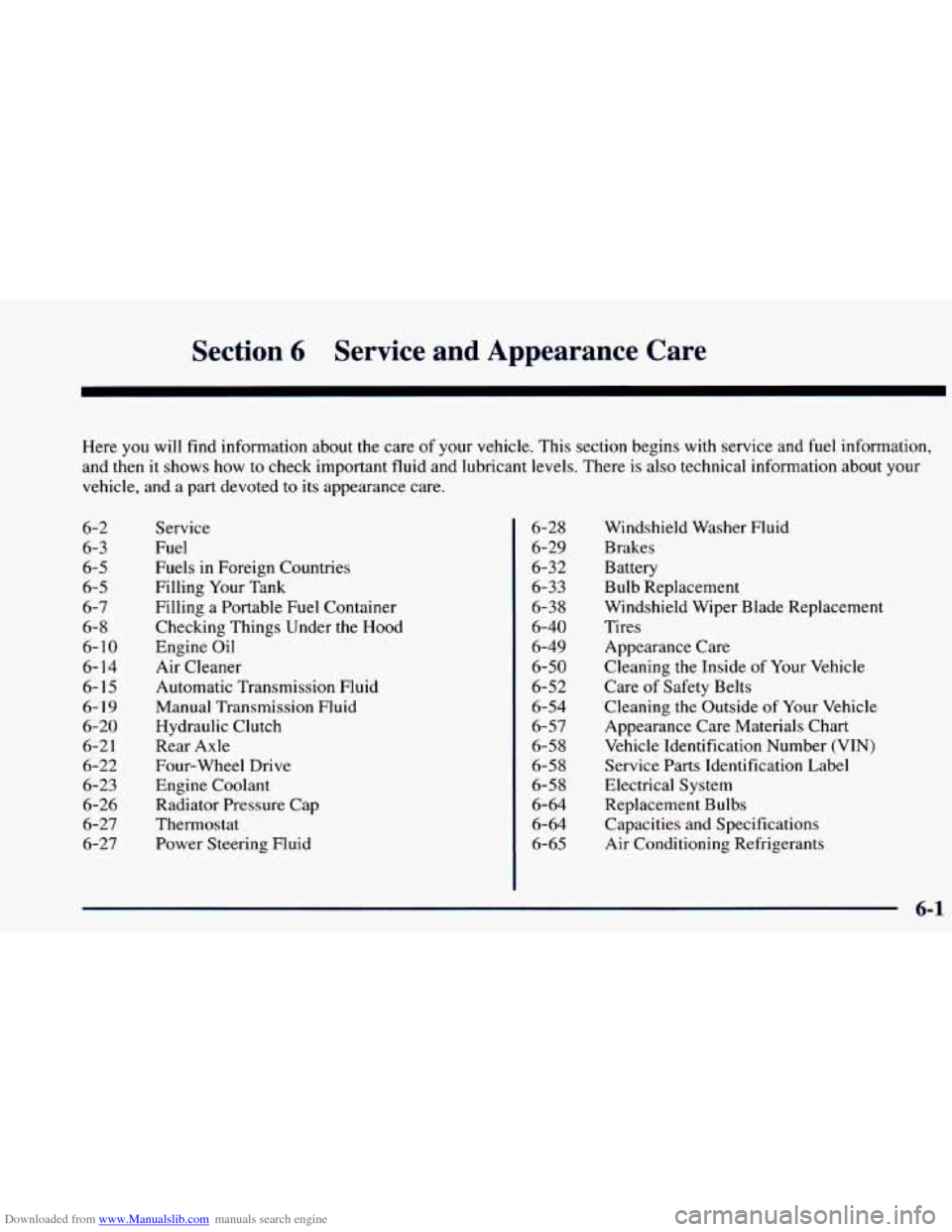
Downloaded from www.Manualslib.com manuals search engine Section 6 Service and Appnara-- ~2 Care
Here you will find information about the care of your vehicle. This section begins with service and fuel information,
and then it shows how to check important fluid and lubricant levels. There is also technical information about your
vehicle, and a part devoted to its appearance care.
6-2
6-3
6-5
6-5
6-7
6-8
6-10
6- 14
6-15
6-1 9
6-20
6-2
1
6-22 6-23
6-26 6-27
6-27
Service
Fuel
Fuels
in Foreign Countries
Filling Your Tank
Filling a Portable Fuel Container
Checking Things Under the Hood
Engine Oil
Air Cleaner
Automatic Transmission Fluid
Manual Transmission Fluid
Hydraulic Clutch
Rear Axle
Four-wheel Drive
Engine Coolant
Radiator Pressure Cap
Thermostat Power Steering Fluid 6-28
6-29
6-32
6-33
6-38
6-40
6-49
6-50
6-52
6-54
6-57
6-58
6-58
6-58
6-64 6-64
6-65 Windshield Washer Fluid
Brakes
Battery
Bulb Replacement
Windshield Wiper Blade Replacement
Tires
Appearance Care
Cleaning the Inside of Your Vehicle
Care
of Safety Belts
Cleaning the Outside
of Your Vehicle
Appearance Care Materials Chart
Vehicle Identification Number (VTN)
Service Parts Identification Label
Electrical System
Replacement Bulbs Capacities and Specifications
Air Conditioning Refrigerants
Page 333 of 416
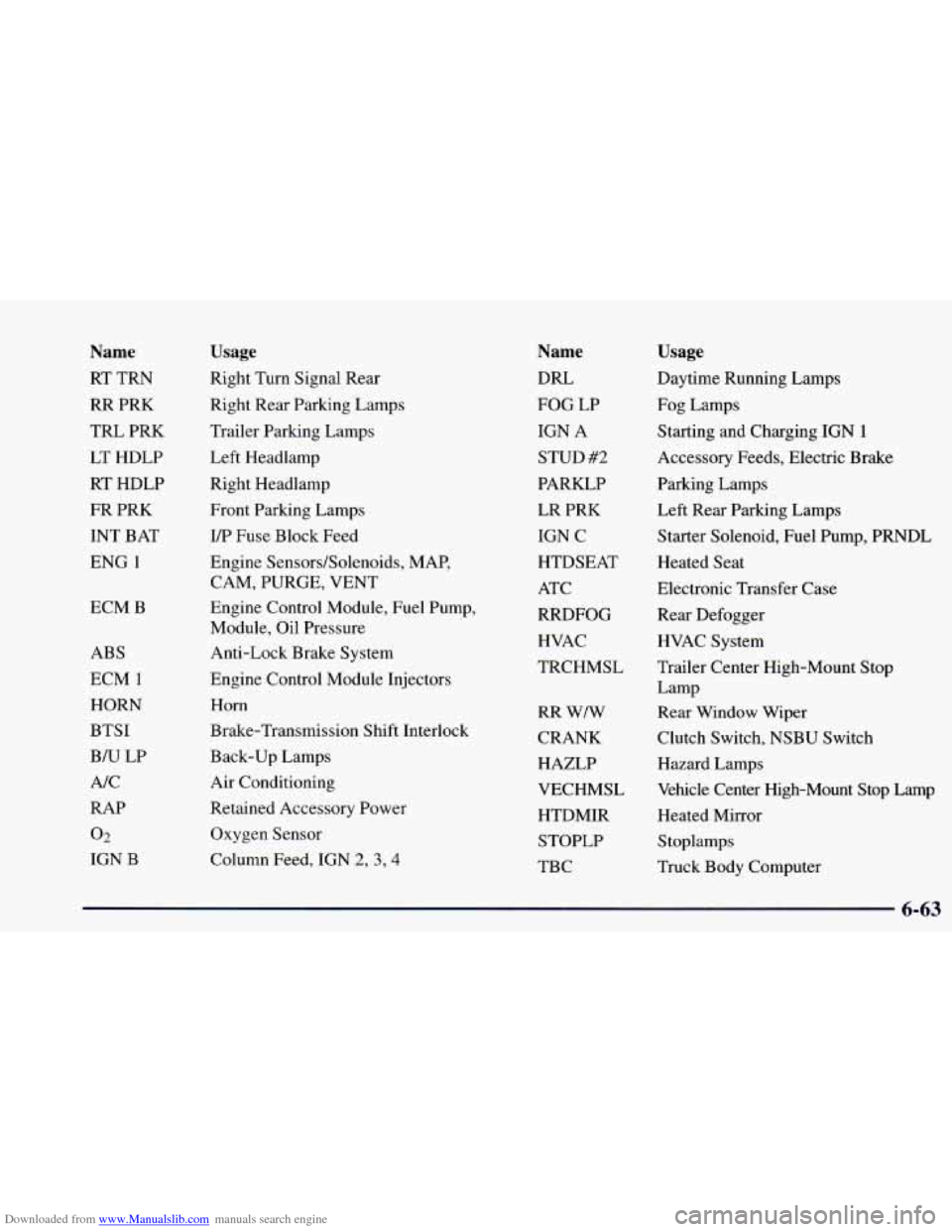
Downloaded from www.Manualslib.com manuals search engine Name
RT TRN
RR PRK
TRL PRK
LT HDLP
RT HDLP
FR PRK
INT BAT
ENG
1
ECM B
ABS
ECM
1
HORN
BTSI
BN LP
NC
RAP
02
IGN B
Usage
Right Turn Signal Rear
Right Rear Parking Lamps
Trailer Parking Lamps
Left Headlamp
Right Headlamp
Front Parking Lamps I/P Fuse Block Feed
Engine Sensors/Solenoids, MAP,
CAM, PURGE, VENT
Engine Control Module,
Fuel Pump,
Module, Oil Pressure
Anti-Lock Brake System
Engine Control Module Injectors
Horn
Brake-Transmission Shift Interlock
Back-up Lamps
Air Conditioning
Retained Accessory Power Oxygen Sensor
Column Feed, IGN
2, 3,4
Name
DRL
FOG LP
IGN A
STUD #2
PARKLP LR PRK
IGN C
HTDSEAT
ATC
RRDFOG
HVAC
TRCHMSL
RR WIW
CRANK
HAZLP
VECHMSL
HTDMIR STOPLP
TBC
Usage
Daytime Running Lamps
Fog Lamps Starting and Charging IGN
1
Accessory Feeds, Electric Brake
Parking Lamps
Left Rear Parking Lamps
Starter Solenoid, Fuel Pump, PRNDL
Heated Seat
Electronic Transfer Case
Rear Defogger HVAC System
Trailer Center High-Mount Stop
Lamp
Rear Window Wiper
Clutch Switch, NSBU Switch
Hazard Lamps
Vehicle Center High-Mount Stop Lamp
Heated Mirror
S toplamps
Truck Body Computer
6-63
Page 335 of 416
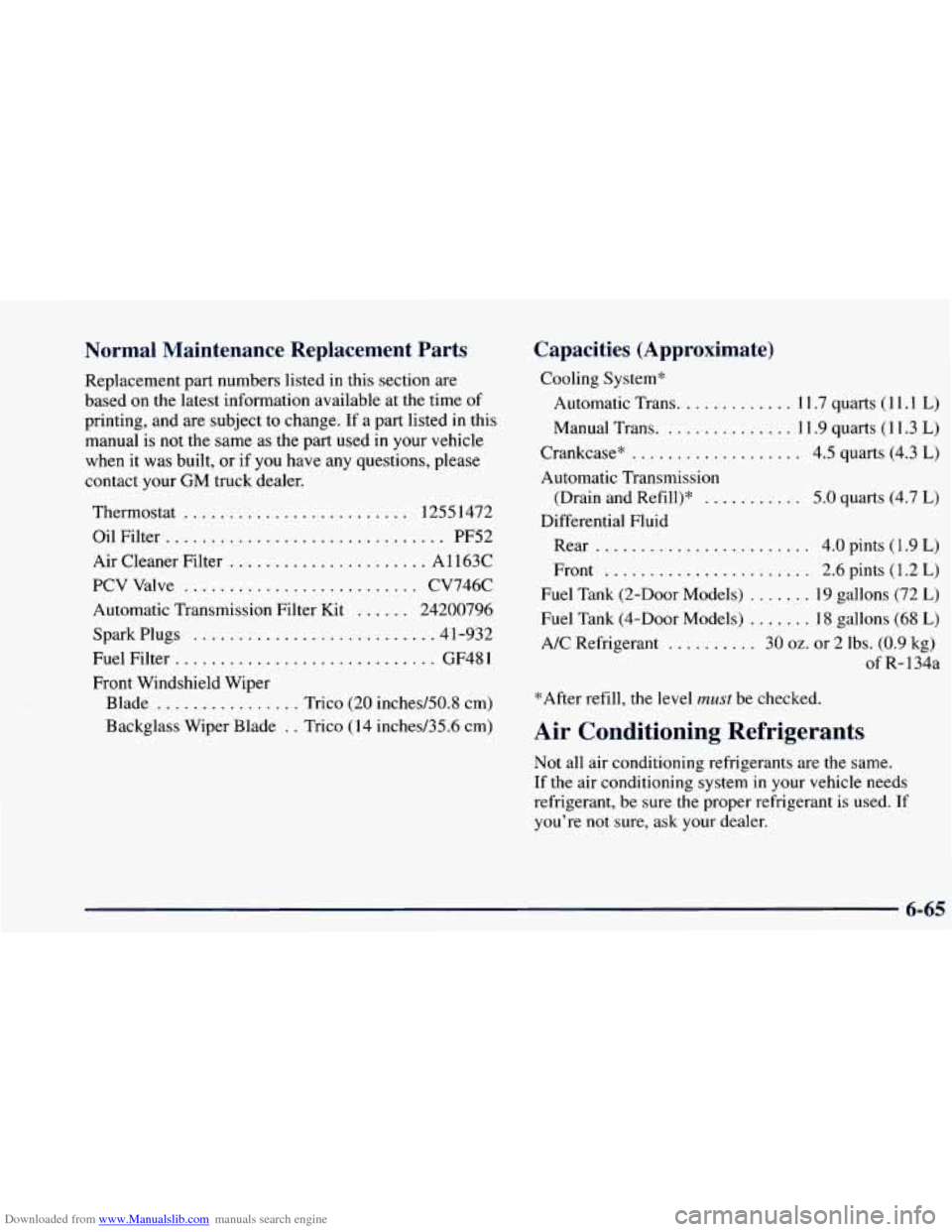
Downloaded from www.Manualslib.com manuals search engine Normal Maintenance Replacement Parts
Replacement part numbers listed in this section are
based on the latest information available at the time of
printing, and are subject to change. If a part listed
in this
manual is not the same as the part used
in your vehicle
when it was built, or if you have any questions, please
contact your
GM truck dealer.
Thermostat
......................... 12551472
Oil Filter
............................... PF52
Air Cleaner Filter
...................... A1163C
PCV Valve
.......................... CV746C
Automatic Transmission Filter Kit
...... 24200796
Spark Plugs
.......................... .4 1-932
Fuel Filter
............................. GF48 1
Front Windshield Wiper
Blade
................ Trico (20 inched50.8 cm)
Backglass Wiper Blade
. . Trico (14 inched35.6 cm)
Capacities (Approximate)
Cooling System*
Automatic Trans.
............ 1 1.7 quarts (1 1.1 L)
Manual Trans. .............. 1 I .9 quarts (I 1.3 L)
Crankcase* ................... 4.5 quarts (4.3 L)
Automatic Transmission
Differential Fluid
(Drain and
Refill)"
........... 5.0 quarts (4.7 L)
Rear ........................ 4.0 pints (1.9 L)
Front ....................... 2.6 pints (1.2 L)
Fuel Tank (2-Door Models) ....... 19 gallons (72 L)
Fuel Tank (4-DOOr Models) ....... 18 gallons (68 L)
A/C Refrigerant .......... 30 oz. or 2 Ibs. (0.9 kg)
of R-134a
*After refill, the level
must be checked.
Air Conditioning Refrigerants
Not all air conditioning refrigerants are the same.
If the air conditioning system in your vehicle needs
refrigerant, be sure the proper refrigerant is used.
If
you're not sure, ask your dealer.
6-65
Page 379 of 416
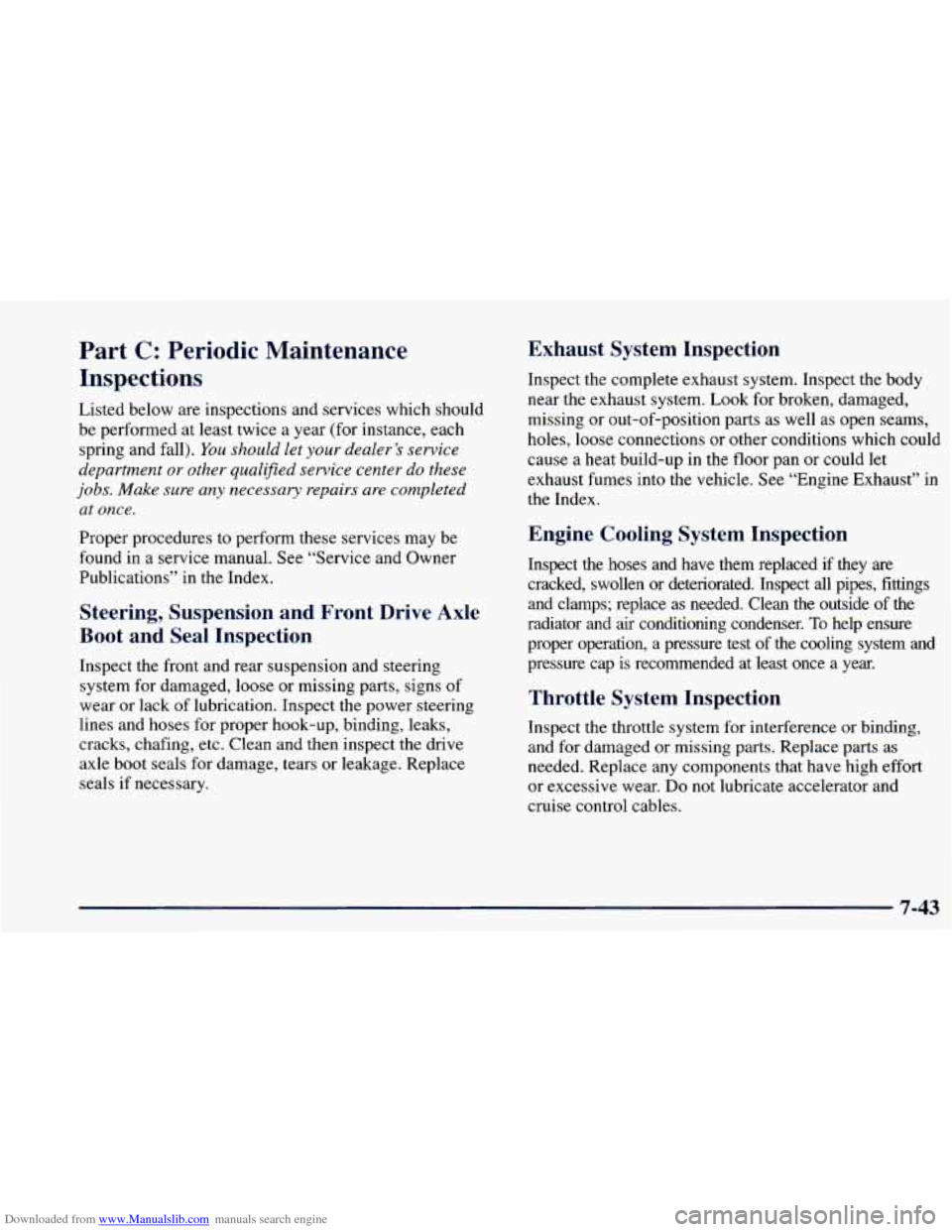
Downloaded from www.Manualslib.com manuals search engine Part C: Periodic Maintenance
Inspections
Listed below are inspections and services which should
be performed at least twice a year (for instance, each
spring and fall).
You should let your dealer’s service
department
or other qualified service center do these
jobs. Make sure any necessary repairs are completed
at once.
Proper procedures to perform these services may be
found in a service manual. See “Service and Owner
Publications” in the Index.
Steering, Suspension and Front Drive Axle
Boot and Seal Inspection
Inspect the front and rear suspension and steering
system for damaged,
loose or missing parts, signs of
wear or lack of lubrication. Inspect the power steering
lines and hoses for proper hook-up, binding, leaks,
cracks, chafing, etc. Clean and then inspect the drive
axle boot seals for damage, tears or leakage. Replace
seals if necessary.
Exhaust System Inspection
Inspect the complete exhaust system. Inspect the body
near the exhaust system. Look for broken, damaged,
missing or out-of-position parts as well as open seams,
holes,
loose connections or other conditions which could
cause a heat build-up in the
floor pan or could let
exhaust fumes into the vehicle. See “Engine Exhaust” in
the Index.
Engine Cooling System Inspection
Inspect the hoses and have them replaced if they are
cracked, swollen or deteriorated. Inspect all pipes, fittings
and clamps; replace as needed. Clean the outside of the
radiator and air conditioning condenser.
To help ensure
proper operation, a pressure test of the cooling system and
pressure cap is recommended at least once a year.
Throttle System Inspection
Inspect the throttle system for interference or binding,
and for damaged or missing parts. Replace parts as
needed. Replace any components that have high effort
or excessive wear.
Do not lubricate accelerator and
cruise control cables.
7-43